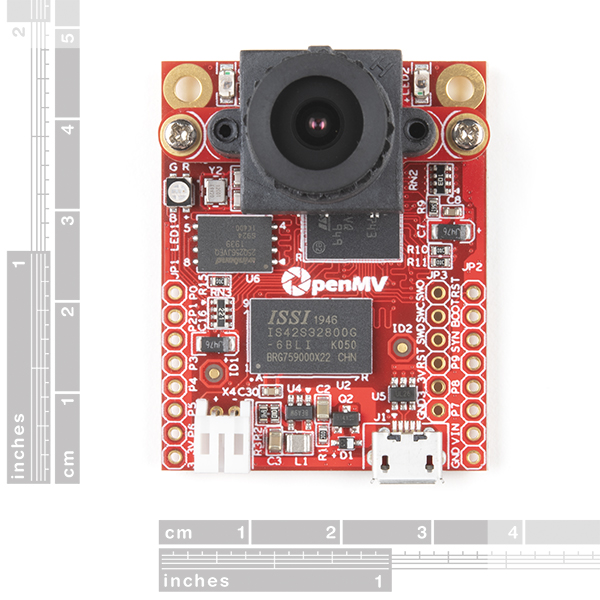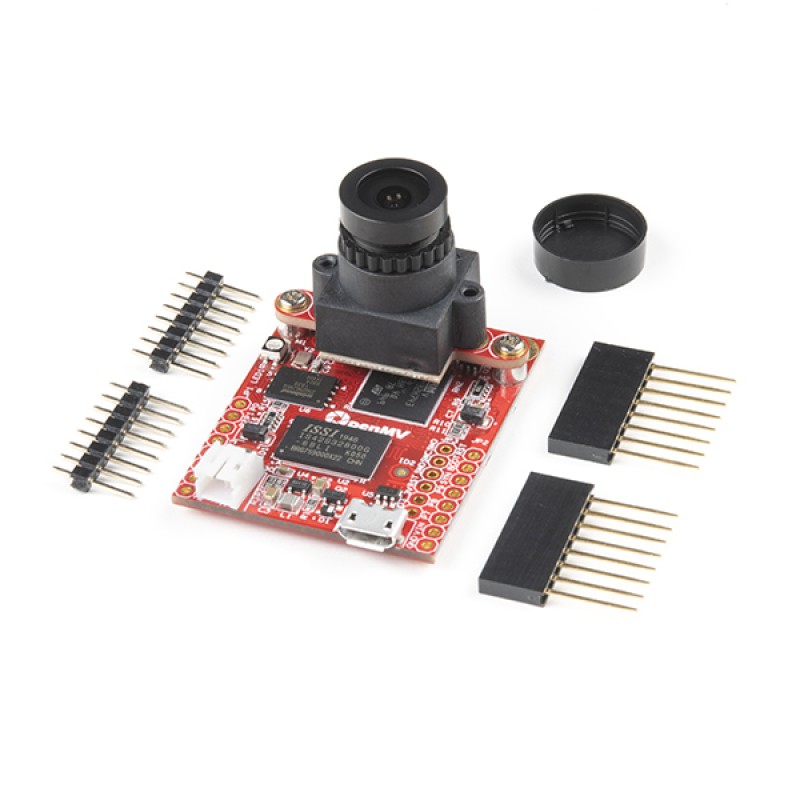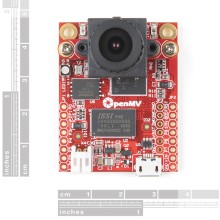OpenMV Cam H7 Plus
The OpenMV H7 Plus Camera is a small, low power, microcontroller board which allows you to easily implement applications using machine vision in the real-world. The Plus variation adds 32 MB of external 32-bit SDRAM and 32 MB of external quad SPI flash. You program the OpenMV Cam in high level Python scripts (courtesy of the MicroPython Operating System) instead of C/C++. This makes it easier to deal with the complex outputs of machine vision algorithms and working with high level data structures. But, you still have total control over your OpenMV Cam and its I/O pins in Python. You can easily trigger taking pictures and video on external events or execute machine vision algorithms to figure out how to control your I/O pins.
The OpenMV Cam H7 Plus comes with a OV5640 image sensor is capable of taking 2592x1944 (5MP) images. Most simple algorithms will run between 25-50 FPS on QVGA (320x240) resolutions and below. Additionally, the OpenMV H7 now features removable camera modules which allow you to use the module with Global Shutter and FLIR Lepton sensors for serious computer vision applications. The OpenMV is perfect for applications involving frame differencing, face detection, eye and marker tracking, QR code detection/decoding, shape detection, and more.

- 1x OpenMV Cam H7 Plus
- 2x 8-pin Male Header
- 2x 8-pin Female Stackable Header
- The STM32H743II ARM Cortex M7 processor running at 480 MHz with 32MBs SDRAM + 1MB of SRAM and 32 MB of external flash + 2 MB of internal flash. All I/O pins output 3.3V and are 5V tolerant. The processor has the following I/O interfaces:
- A full speed USB (12Mbs) interface to your computer. Your OpenMV Cam will appear as a Virtual COM Port and a USB Flash Drive when plugged in.
- A μSD Card socket capable of 100Mbs reads/writes which allows your OpenMV Cam to take pictures and easily pull machine vision assets off of the μSD card.
- A SPI bus that can run up to 80Mbs allowing you to easily stream image data off the system to either the LCD Shield, the WiFi Shield, or another microcontroller.
- An I2C Bus (up to 1Mb/s), CAN Bus (up to 1Mb/s), and an Asynchronous Serial Bus (TX/RX, up to 7.5Mb/s) for interfacing with other microcontrollers and sensors.
- A 12-bit ADC and a 12-bit DAC.
- Two I/O pins for servo control.
- Interrupts and PWM on all I/O pins (there are 10 I/O pins on the board).
- And, an RGB LED and two high power 850nm IR LEDs.
- 32 MB of external 32-bit SDRAM clocked at 100 MHz for 400 MB/s of bandwidth.
- 32 MB of external quadspi flash clocked at 100 MHz in 4-bit DDR mode for 100 MB/s of bandwidth (read speed).
- A removable camera module system allowing the OpenMV Cam H7 to interface with different sensors:
- The OpenMV Cam H7 Plus comes with a OV5640 image sensor is capable of taking 2592x1944 (5MP) images. Most simple algorithms will run between 25-50 FPS on QVGA (320x240) resolutions and below. Your image sensor comes with a 2.8mm lens on a standard M12 lens mount. If you want to use more specialized lenses with your image sensor you can easily buy and attach them yourself.
- For professional machine vision applications you can buy our Global Shutter Camera Module.
- For thermal machine vision applications you can buy our FLIR Lepton Adapter Module.
- A LiPo battery connector compatible with 3.7V LiPo batteries commonly sold online for hobbyist robotic applications.
- Base Schematic
- OV5640 Schematic
- OpenMV Camera Tutorial
- OpenMV IDE
- On-Board Module Datasheets
- Document Page
- OpenMV Resource Page
Uses include:
- Frame Differencing
- Color Tracking
- Marker Tracking
- Face Detection
- Eye Tracking
- Optical Flow
- QR Code Detection/Decoding
- Data Matrix Detection/Decoding
- Linear Barcode Decoding
- AprilTag Tracking
- Line Detection
- Shape Detection
- Template Matching
- Image Capture
- Video Recording




